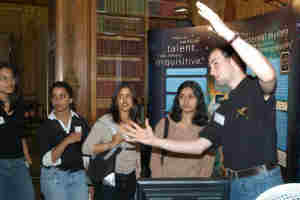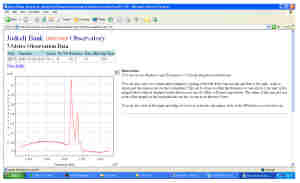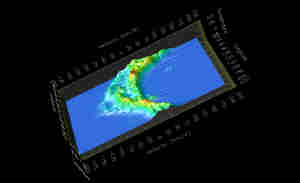JBO Outreach at the Royal Society and Royal Institution
"Fatal Attraction" at the Royal Society
9th August 2005
Astronomers from Jodrell Bank Observatory, University of Manchester, were selected from a large group of applicants to present their research at the prestgious Royal Society Summer Science Exhibition in London from July 4th through 7th. The exhibit, dubbed "Fatal Attraction", describes their discovery of a new double-pulsar system and how it is being used to make the most stringent tests so far of Einstein's theory of general relativity.
A pulsar is a rapidly rotating neutron star formed as a result of the supernova explosion of a massive star. Pulsars rotate at extremely rapid rates (up to 642 Hz!) and emit beams of radio waves which are studied using instruments such as the 76-m Lovell Telescope at Jodrell Bank. The double pulsar system consists of a pair of neutron stars which orbit each other every 2.4 hours, travelling at speeds of around 330 km/s (0.1% of the speed of light). According to Einstein's theory, the separation of the pulsars will shrink as the as the system emits gravitational waves - small ripples in space time that travel across the Universe. By observing the regular radio pulses received from each pulsar - which act as incredibly precise clocks - the team has shown that they are moving closer together by 7 mm a day, in exact agreement with Einstein's theory! The orbits will continue to shrink for the next 85 million years, when the pair will collide, probably forming a black hole.
The Jodrell Bank exhibit featured a 3D movie showing the ultimate fate of the system along with informative posters and hands-on displays illustrating the physics of pulsar binary systems. The exhibitors were very impressed by the level of interest generated by the public and enjoyed many stimulating discussions throughout the week.
"Excitement of Science" at the Royal Institution.
A highly innovative initiative to bring the work of the Observatory to school children across the United Kingdom was the 2005 "Excitement of Science" project sponsored by the Royal Institution and the Rotarians. Via the web, the observatory gave access to its 7-metre telescope to over 50 schools who used it to observe the spiral structure of the Milky Way. In this unique scientific programme, each school was asked to observe eleven, 4-square degree areas along the plane of the Galaxy and did so by operating the telescope over the internet. Their observations were collated at Jodrell Bank and combined together to make a map showing the spiral structure of the Galaxy (see figures 1 and 2.) The complete data set showing the detailed structure of three spiral arms (the Local Arm, the Perseus Arm and the Outer Arm) were unveiled during a day of talks and demonstrations in June 2005 by the project leaders, University academic staff, Tim O'Brien and Ian Morison. In addition to an audience of several hundred school children at the Royal Institution the event was simultaneously web-cast to schools across the country.
Figure 1: An internet page showing students the data that they have collected with the 7-Metre telescope. The plot shows a spectrum of the atomic hydrogen emission in one part of the galactic plane. The three peaks relate to gas in different spiral arms and are the raw data from which a map of the spiral structure of the galaxy can be determined.
Figure 2: A visualisation of the some of the clouds of hydrogen that make up our Milky Way galaxy showing the presence of three spiral arms.





